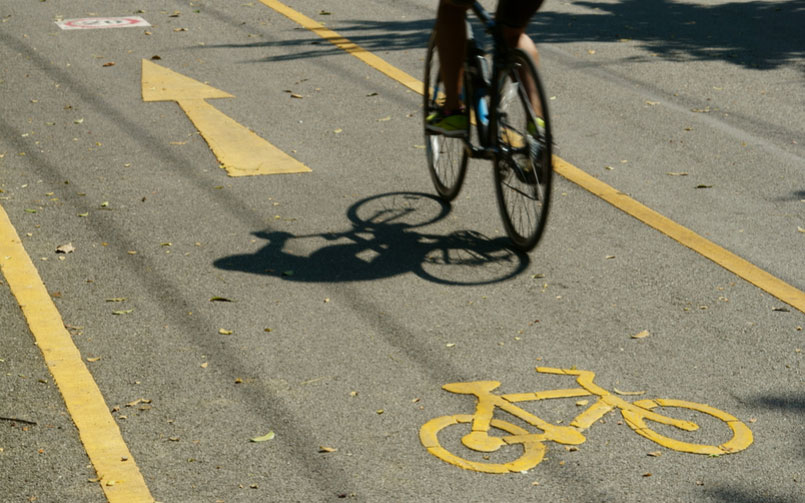Separated bicycle lane design planning can be an extensive process but rest assured the results are typically worth the efforts. Adding barriers, new street signs, and extended lanes can change the entire look and feel of a street, as well as make it safer for everyone. It can also create more room for retail growth and productivity, while increasing local real estate values.
So, what makes us so knowledgeable on separated bicycle lane design and planning? TerraCast Products are commonly used as barriers in separated bike lanes. That’s because our resin-based products are specially formulated and made right here in America for long term durability. Our planters, lighting fixtures, and other site furnishings can withstand everything from harsh weather to dings from passing motorists and bicyclists.
Here’s an overview of special considerations, planning issues, as well as research and analysis that needs to be conducted during separated bicycle lane design planning.
1. How to Tackle Common Separated Bicycle Lane Design Planning Issues
The planning and design phase includes things like assessing funding options, conducting outreach with the community, and collecting data before, during, and after implementation of separated bike lanes. The first step to tackling common issues that come up during the planning phase is to know what they are ahead of time.
The most common issues regarding bicycle lane design occur because one or more of the following gets overlooked during the planning process:
Cost: How much do separated bike lanes cost? There are a wide variety of factors that’ll influence cost, such as the materials used, size of the project, and so forth.
Funding: Who will cover the costs of separated bike lanes? Funding may be available through Federal programs, State or local contributions such as dedicated taxes, nonprofit organizations, and private sector sources.
Maintenance: Separated bike lanes require ongoing maintenance which should be figured out and delegated during the planning stage.
Outreach: Reaching out to local community members before, during, and after construction of separated bike lanes is an important part of the process. Outreach includes offering educational materials regarding the project and its intended results. It’s equally important to talk with locals and ask for input on how to better plan bike lanes for usability and convenience. Locals who regularly use streets can offer telling insights.
Coordinating with Agencies: A variety of different agencies may coordinate on one separated bike lane. There are different public agencies that deal with traffic safety, enforcement, maintenance, emergency vehicle access, and so forth.
2. Don’t Forget to Make Special Considerations
Don’t forget to take in account:
- How bike lanes will impact roadway capacity
- How bike bikes impact pedestrian safety
- The addition of transit corridors, loading and unloading zones
- Are bike lanes accessible—how can bike lanes interconnect throughout the city?
- Is the same amount of parking still accessible? Does new parking need to be added elsewhere to accommodate?
3. The Importance of Collecting Data and Evaluating Results
Separated bike lanes offer greater safety for everyone who uses sidewalks, bike lanes, and even traffic lanes. To showcase these benefits, it’s important to collect data before, during and after implementation of bike lanes.
A holistic evaluation must be conducted in which all types of motorists and pedestrians are taken into consideration. Determine who uses roadways and for what purpose—before and after separated bike lanes are installed. Also, keep track of any changes in accidents, fatalities and injuries.
Traffic volume and vehicle speeds should also be tracked before and after separated bike lanes are implemented. Keep tabs on any growth in local retail, as well as environmental and public health effects. All this information helps highlight the benefits of separated bike lanes, and it can also offer room for improvements.
Data collection needs to be consistent in terms of methodology and “data collection technology.” Reliable data is key to proving your findings on the effects of separated bike lanes.
4. Picking the Right Separated Bike Lane Barriers
The barriers you use for separated bike lanes are an important part of the planning process. Commonly used barriers include planters, trees, lighting fixtures, or bollards—just to name a few. The barrier you pick will influence the type of maintenance and upkeep required. For instance, planting trees or rows of planters requires routine plant care. Relying on self-watering planters and native plants can help reduce maintenance. On the other hand, adding bollards requires regular cleaning of things like bird poop, roadway splatters, graffiti, etc.
Speaking of graffiti… graffiti is yet another reason so many people turn to TerraCast Products for separated bike lane barriers. Our products are made from a resin-based non-porous material that doesn’t absorb moisture or stains like porous materials such as concrete or stone. Since stains don’t penetrate the top layer it’s much easier to clean things like paint or graffiti. Remove just about anything from our products using a Mr. Clean Magic Eraser Wipe.
There’s good reason our planters are featured in New York City’s Times Square. If our planters are durable enough to withstand one of the most heavily populated areas in the world, imagine how many benefits they could offer you? Shop our complete collection of planters here.
Need durable bike racks? We’ve got those too—check them out here!

